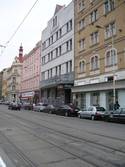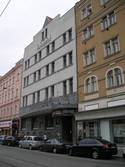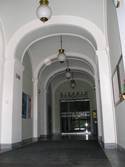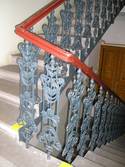Under Palmovka Theatre
Václav Romováček
alias Municipal and Regional Theatre in Prague Libeň (1949- 1951), Municipal and Regional Theatre in Prague Žižkov (1948- 1949), New People's Theatre Prague VIII. in Libeň (1905), Marie Zieglerová Theatre in Prague VIII. (1908), People's Theatre Prague VIII. (1909), cinema Svépomoc (1932), S. K. Neumann Theatre (1951- 1990)Zenklova 34, | |
| show on the map |
Important events
1965-09-18 A permit for the installation of neon advertisement above the entrance.
1966-09-14 Building permit for cloakrooms and technical rooms
1967-05 Replacement of the ceiling and establishment of a storage room for costumes (at the end of the yard, behind no. 321 and 327 Na hrázi street)
1967-07 to 09 Replacement of the entrance door made of oak tree with brass fitting and fluorescent lamp designed by prof. Rothmayera
People
Czech arcjitect and builder,worked predominantly in Prague.
Source: Vlček, Pavel a kol. : Encyklopedie architektů, stavitelů, zedníků a kameníků v Čechách, str. 554, Praha 2004.
History
Today‘s Divadlo pod Palmovkou in Libeň (Zenklova 34, no. 566) has a long tradition and a complicated history. As early as in the 1860s the amateur actors organized their performances here in the wayside inn called U Deutschů. Later, a large dance hall was built in the garden of the tavern. This dance hall was adapted and used as a theatre after one of its later owners Jan Hurt acquired a license to operate a theatre in 1892. Various theatre companies had performed there since that year. In 1899, the tavern was bought by a renowned Prague architect Václav Romováček. He decided to pull down the whole building in 1903 and built a modern hotel with a café there. A year later, he replaced the old theatre hall with a new, more spacious building. The soubrette of Svandovo divadlo Marie Groszová became the new owner of the theatre. Václav Romováček redesigned the hall to suit the purposes of a theatre with the capacity for 495 seated visitors and 400 standing visitors. The theatre group of Marie Groszova performed here under the name Nové lidové divadlo Praha VIII v Libni. The theatre was first opened on 16 December 1905, however, after about a year and a half, Jaroslav Sedláček became the new owner. The soubrette Marie Zieglerová bought it from him in 1907, and arranged for the adaptation of the auditorium to suit the musical play performances. The design of the interior was also improved with a new refurbishment of the foyer (managed again by Václav Romováček). The new Divadlo Marie Zieglerové started its operation on 23 January 1908 with Lehár’s The Merry Widow. However, due to financial difficulties the activities ceased by the end of the same year and the hall with the attached buildings were sold in an auction. In 1909, the theatre group lead by Arnošt J. Frýda performed here under the name Lidové divadlo Praha VIII, which was also not successful. The building then became the property of the social democratic party which converted the theatre hall into a cinema named Svépomoc. Amateur theatre groups also performed there for some time, and the situation started improving in 1948 when a group, which was originally established by Antonín Kurš in the theatre Akropolis in Žižkov, came to perform in Libeň. Under the name Městské a oblastní divadlo and managed by a new theatre director Jan Strejček, the group performed its first play Jiříkovo vidění (George’s vision) by J.K. Tyl on 31 August 1948 in the improvised conditions of the hall. Then, a reconstruction of the building according to the project of Bohuslav Kodera a František Kadlec followed. The first performance after this reconstruction took place on 27 October 1949 with Kornejčuk’s Makara Dubravy, and on 2 December of the same year the theatre launched its permanent operation with Tyl’s Fidlovačka. After that, the stage had been active for four decades under the name Divadlo S. K. Neumanna. Within this period the theatre won a respectful status among Prague scenes. On 27 September 1990, it was renamed to Divadlo pod Palmovkou.
Current condition
The theatre is housed in an attached town house. Its main wing in the yard was designed in neo-renaissance style by Václav Romováček during the reconstruction in the period of 1903–1905. The design combines historical features with secession decoration. The front façade has four axes, and three floors with an attic. There are joint windows on the otherwise undivided surface, which are connected by the molding above and under the windows; there is one window in the axis of the attic, under which there is a sign with the name of the theatre in metal letters. There is an entrance on the ground level on the right which has a granite coating and is shaded with a sunblind. Another sunblind above it spreads across the whole façade.
The rectangular entrance is vaulted by five fields of flat vault separated by distinct belts on pillars attached to the wall. On the left, there is an entrance to the theatre café which was refurbished during the reconstruction in 2002. The front glass doors lead to the foyer which also had to be newly refurbished. At least the original mosaic floors dating back to 1903–1905 were preserved. The slightly slant floor in the stalls is divided into two parts: behind the first eleven rows with sixteen seats, there are another four rows with twice twelve and twice ten seats. This area is at some places raised. The circle is divided by a transverse alley behind the first four rows with fifteen seats. Behind these seats there are three rows with twelve seats divided by a vertical alley leading to the entrance. There are two slightly lowered arms connected to the front circle which reach to the stage portal and are partly used for stage lights. The stage portal is rectangular with round edges; the orchestra pit is covered by the proscenium floor. The ceiling of the auditorium, which is divided into right-angled fields with stucco belts, is supported by massive cavetto with lunettes. The parapet of the front circle carries a relief emblem of Libeň in the middle. The parapets of the side arms of the circle carry either stucco belts with secession floral ornaments, or female masks. Side walls are decorated with circular thumb sketches with female heads with symbols of hammer and a sickle in their hair. The dating of these sketches is not known.
Resources and literature:
- Stavební archiv městské části Praha 8
- Javorin, Alfred: Divadla a divadelní sály v českých krajích, Praha 1949; I. díl, s. 233-236.
- Maršálek, Josef: Divadlo S.K. Neumanna 1948-1958; Praha 1958
- Macháčková, Kateřina: Sto let v Libni; Road to Liben - zvláštní příloha týdeníku Reflex 15.12.2005
Tags: Austria-Hungary, Neo-Renaissance, Art Nouveau, Belle Époque, terraced house, theatre hall
Author: Jiří Hilmera
Jiří Hilmera:
Karlovy Vary City Theatre, Minor Theatre, Vinohrady Theatre, Theatre in Celetna, Silesian Theatre Opava, State Opera, Estates Theatre, Jára Cimrman Žižkov Theatre, Theatre without a Balustrade, Kalich Theatre, Costanza e Fortezza, The Ungelt Theatre, Theatre in Mozarteum, Municipal Theatre Mariánské Lázně, Phasma Dionysiacum Pragense, J. K. Tyl Theatre Třeboň, Theatre in the Wallenstein Palace Garden, The Realm of Puppets, Braník Theatre, Dejvické Theatre, Stone Theatre, Theatre Na Jezerce, Theatre Na Prádle, Ponec Theatre, Theatre in Dlouhá, Strašnice Theatre, Semafor, Under Palmovka Theatre, Ypsilon Studio, Competition Hradec Králové, Ostrava competition for a building of opera 1958-1959, Theatre designs by Josef Gočár, Beskydy Theatre CompetitionTranslator: Zdislava Kratěnová
Zdislava Kratěnová:
Theatre in Celetna, State Opera, Town Theatre Krnov, Municipal Theatre of K. H. Mácha Litoměřice, Tyl's House in Polička, Hybernia Theatre, Švanda's Theatre in Smíchov, Mahen Theatre Brno, ABC Theatre, The Realm of Puppets, Klicpera's theatre Hradec Králové, Dejvické Theatre, Theatre Na Jezerce, Theatre Na Prádle, Ponec Theatre, Theatre in Dlouhá, Under Palmovka Theatre, Palace Theatre Hluboká nad VltavouAdditional information
No information has yet been entered
Add information





























